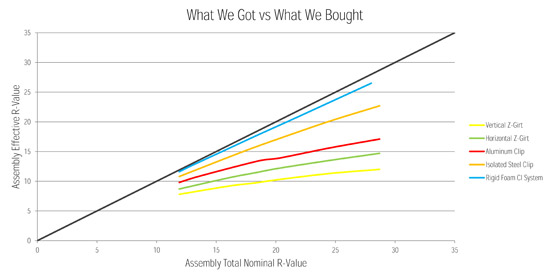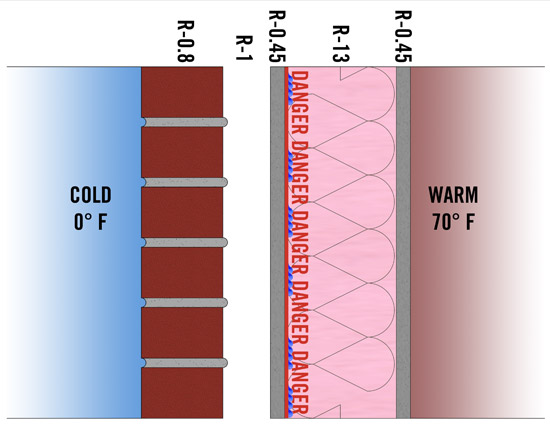Conforming to Code
Increasing the exterior insulation thickness to 3 inches increases the nominal R-value of the exterior insulation by R-8.9. Overall, this system has a much higher effective assembly thermal resistance than the previous cases as one would expect, and the effective thermal resistance is, again, 80 percent. The overall percent effective of the assembly as a whole is once again lower due to the effects of thermal bridging from the steel studs.
If the spacing of the fasteners is changed to a more practical and typical spacing of 16 inches o.c. vs 8 inches o.c. vertically, the effect on the overall thermal resistance increases by just less than an R-1 for 1.5 inch insulation thickness, creating an 83 percent effectiveness vs 80 percent.
Replacing the 1.5 inches of rigid insulation with 3 inches of insulation while increasing the fastener spacing boosts the system's thermal resistance by R-1.4. The reason for the increased thermal resistance is as more insulation is added, more heat will try to flow out of the screws. As result, changing screw spacing's will have a greater effect. This increases the effectiveness of the thermal resistance to 86 percent.
With interior insulation in the ci attachment system, significant gains with reduced bridging in the exterior insulation are blurred by heat flow bypassing the interior insulation through the stud cavity. Without stud cavity insulation, the effective R-value of the assembly as a whole is R-12.5. This is within less than half an R-value compared to the total nominal resistance of the assembly (R-12.8), which is 97 percent effectiveness.
Again, replacing the 1.5 inches of rigid insulation with 3 inches of insulation and removing the insulation within the stud cavity, the difference between the nominal and effective assembly R-value is only R-1. As with any insulated assembly that contains thermal bridges of any kind, there is still a diminishing return with increasing insulation; however this decrease is minor and the system is still 95 percent effective, indicating that the exterior fasteners are very effective in reducing thermal bridging through the exterior insulation compared to penetrating continuous vertical or horizontal girts.
 |
|
This figure summarizes the insulation effectiveness for various assemblies. Click to view large table image. Courtesy of Knight Wall Systems |
Cost Implications
The performance of a wall has several implications. First, it has a dramatic effect on a building's operational expenses. With the average cost of a kWh of electricity in 2011 at nearly 12 cents (eia.gov), reducing heating and cooling HVAC workloads can translate to substantial cost savings over the life of a building. When an R-19 batt insulated steel framed wall, 4-inch deep vertical and horizontal Z-girt assemblies and a 4-inch deep thermally isolated intermittent bracket system are compared for kWh/SF used, the bracket system shows superior performance. The intermittent bracket system reduces heat transfer through assemblies so that space heating power uses ± 55 percent less kWh compared to batt and ± 38 percent and ± 28 percent less compared to vertical and horizontal Z-girts respectively. Being that a thermally isolated intermittent bracket system has less thermal bridging and performs much better than continuous furring strips, the overall thickness of insulation required for code compliance is reduced, saving material costs. Furring strips require more than 6 inches of exterior mineral fiber insulation or over 4 inches of rigid foam, whereas some intermittent isolated bracket systems can require as little as 3.5 inches of mineral fiber, or a ci attachment system with as little as 2.5 inches of rigid foam insulation. In fact, it is impossible to be at or below a maximum U-factor of 0.064 with steel stud assemblies and continuous vertical or horizontal Z-girts with 6 inches of mineral fiber insulation or less or ±4 inches of rigid foam. Note that there are several types of rigid foams with different R-values, therefore some rigid foams may be 3.5 inches and others 4.25 inches.
By using these techniques to reduce the thermal bridging, not only is the overall performance of the wall dramatically increased, the thickness of insulation required to meet code can be reduced. The result: a decrease in the cost per square foot per R-value of insulation required, and a reduction in overall wall thickness, leaving the owner with more overall useable or leasable floor area. Thinner wall profiles also mean a reduction in trim flashing at windows and doors and associated labor costs. Today it is more important than ever to get the insulation equation right. As the glazing area increases—which it typically does in modern buildings—the importance of the opaque wall assembly's insulation effectiveness increases. High glazing ratios begin to kill the overall efficiency of the entire wall assembly at an exponential rate, so better performing insulation methods become ever more critical to keep energy usage and operating costs in check.
| Hidden Benefit of CI—Elimination of Condensation | ||
In the accompanying figure, note that the right side is the warm inside, left side is the cool outside. In this illustration, the problem is in the cavity—this is where condensation is most likely to occur. In fact, the danger point is a specific place – on the interior side of the exterior sheathing. With the importance of temperature paramount when it comes to condensation, the most important characteristic to know is the temperature at this location. R-values can be used to determine temperature. Since the R-values to the inside of the wall are much greater than the outside, the danger zone will have a temperature much closer to the outside temperature than the inside temperature. The temperature at the sheathing in this example is 10F, and an interior humidity of only 8 percent would be enough for condensation to form. Yet if the exterior insulation is dominant, the point of condensation, or dew point, will be dramatically different. This shift in insulation from interior to exterior creates a much warmer stud cavity. With a stud cavity now at the temperature of the conditioned space, the likelihood of condensation is reduced. In short, condensation is a temperature related phenomena, and shifting the position of the insulation has dramatically changed the temperature.
|










